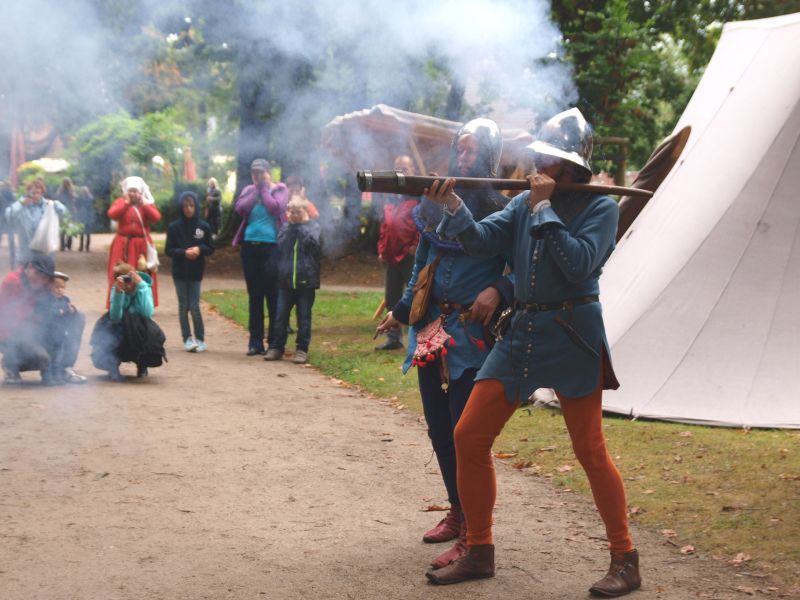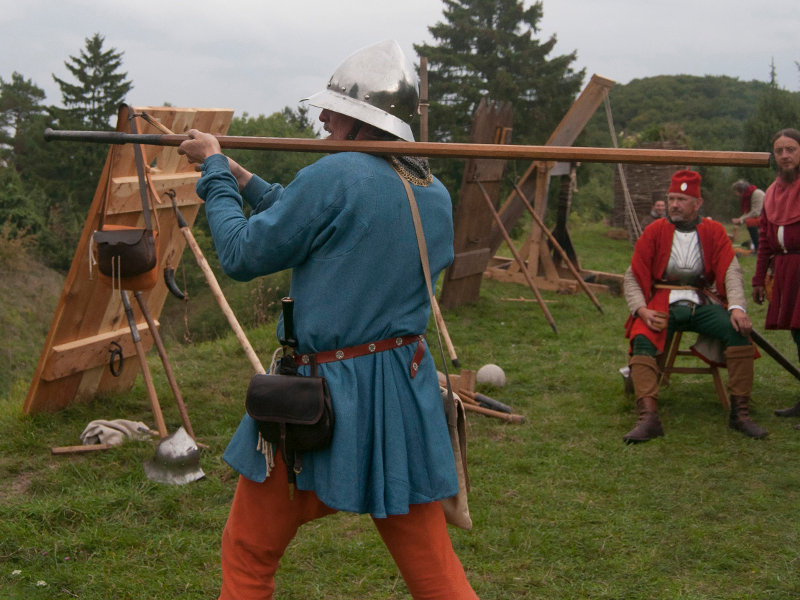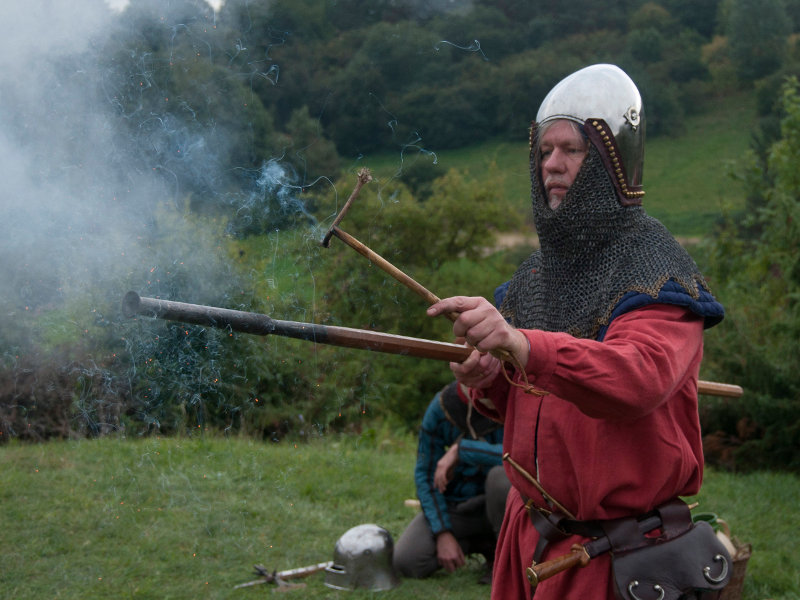
Contemporary documents from the 15th and early 16th centuries provide a wealth of illustrations of how historical riflemen donned and fired their weapons.
In addition, some master gunsmiths left more or less detailed instructions on the handling of firearms in their books. All these documents together make it possible to reconstruct the handling of historical firearms with relative certainty. In the following we present some frequently reproduced types of handling with their advantages and disadvantages. The historical pictorial documents, as well as some preserved weapons1) show that there were both right-handed and left-handed shooters among the historical shooters. All the types of attacks are described here as examples for right-handed shooters, and the attack for left-handed shooters is to be implemented accordingly as a mirror image. However, even with the best sources, a certain caution is required when evaluating the historical images and text documents and a source-critical approach to interpretation is advisable.
Free Standing Aiming Types
On the Shoulder
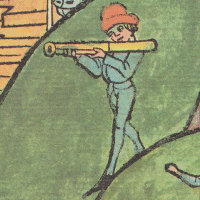
 This is the most common way of shooting in historical illustrations. The rifle stock is placed on the right shoulder, the right arm is more bent and holds the stock just in front of the shoulder, the left arm guides the rifle further forward on the barrel. The aiming is done with the right eye over the barrel of the rifle and the firing is done by a second man. The shooting instructions from a fireworks book of the Austrian National Library in Vienna from 1457 fit to this type of aiming
This is the most common way of shooting in historical illustrations. The rifle stock is placed on the right shoulder, the right arm is more bent and holds the stock just in front of the shoulder, the left arm guides the rifle further forward on the barrel. The aiming is done with the right eye over the barrel of the rifle and the firing is done by a second man. The shooting instructions from a fireworks book of the Austrian National Library in Vienna from 1457 fit to this type of aiming
"… lass die Büchs anzünden und wenn du empfindest, dass sie hinter sich stösst, so widerheb nicht zu stark, doch halt den Stab in der vordern Hand fest und damit lass die vordere Hand, also den Stab darinnen haltend, gegen die hintere Hand gehen und lass den Stab durch die hintere Hand hinter sich ausschliefen." 2)
(…let the gun be lit and if you feel that it pushes behind you, do not resist too strongly, but hold the staff in your front hand and with it let the front hand, thus holding the staff inside, go against the back hand and let the staff be pushed out behind you by the back hand.)
This aiming type allows the rifle rod to slide back on the shoulder as described above in the case of stronger recoil.
- Advantages: Safe, controllable hold of the rifle, very good aiming over the barrel. Shots with higher recoil loads possible.
- Disadvantages: Second man needed to ignite the box.
- Application: Direct precision shots, also over longer distances.
- Remarks: This type of stop allows the rifle to be held and aimed quietly and safely. Shots with a higher charge and greater recoil are possible. Firing the rifle with the right hand is awkward, but also possible. This type of stop corresponds roughly to the free-hand standing shooting of modern rifle shooters, with the difference that the rifle stock rests on the shoulder instead of being retracted at the shoulder. This type of stop must have proved so successful that it was still used until the end of the 16th century.3)
Images: Left: Kriegstechnische Bilderhandschrift, Zentralbibliothek Zürich Ms Rh hist 33b, Fol. 044r. Right: Die Belagerung von Neus. Konrad Pfettisheim: Geschichte Peter Hagenbachs und der Burgunderkrieg. Straßburg 1477.
On the Shoulder Over the Same Arm

 This type of firing is very rarely found in historical sources. The illustration opposite shows a left-hand shooter. In the right-handed shooter, the stock is placed on the right shoulder and the rifle is held with the right hand. Sighting is done with the right eye over the barrel of the rifle and firing is done with the left hand.
This type of firing is very rarely found in historical sources. The illustration opposite shows a left-hand shooter. In the right-handed shooter, the stock is placed on the right shoulder and the rifle is held with the right hand. Sighting is done with the right eye over the barrel of the rifle and firing is done with the left hand.
- Advantages: Can be operated by a single man, good aiming via the rifle barrel.
- Disadvantages: Unsteady and relatively unsteady hold of the rifle, shots only with low-recoil rifles and loads.
- Application: Precision firing at shorter to medium distances or situations in the field where a second man is not available for firing.
- Remarks: The rifle rests only on the shoulder and must be held by a relatively long arm. Due to the more uncertain and wobbly stop, only shots with a low-recoil charge are possible. The biggest and so far only discernible advantage is that it can be operated by a single man, even if the shooter's attention is momentarily diverted from the target when firing. Due to the kinetic movements during firing, the above-mentioned shooting instructions from 1457 are not applicable to this type of firing.
Images: Left: Stundenbuch der Maria von Burgund um 1470 fol. 47v. Right: Die Eroberung Jerusalems durch die Kreuzfahrer 1099. Aegidius van Roya: Compendium historiae universalis. Niederlande um 1450-1460. Den Haag, MMW 10 A 21, Fol. 178r.
Under the Armpit
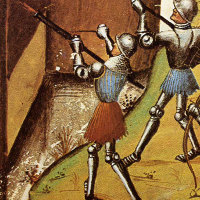
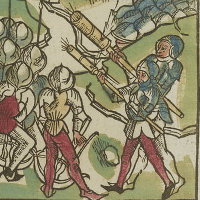 This type of firing position is reminiscent of the modern hip firing position used in stalking or Deutschschießen (literatlly: German shooting, low point shooting).3) This style can often be found in historical illustrations. The rifle stock is clamped under the right armpit or a little lower between the right upper arm and the torso, the right hand holds the rifle stock a little further forward. The rifle is guided with the left hand in front. Sighting is intuitive. The ignition is triggered by the shooter himself or by a second man
This type of firing position is reminiscent of the modern hip firing position used in stalking or Deutschschießen (literatlly: German shooting, low point shooting).3) This style can often be found in historical illustrations. The rifle stock is clamped under the right armpit or a little lower between the right upper arm and the torso, the right hand holds the rifle stock a little further forward. The rifle is guided with the left hand in front. Sighting is intuitive. The ignition is triggered by the shooter himself or by a second man
- Advantages: Safe and steady hold of the rifle, firing is possible by the shooter himself.
- Disadvantages: Aiming is not possible directly, but only intuitively.
- Application: Direct or ballistic shots at close-standing enemy army clusters, direct or ballistic shots at higher-lying targets.
- Remarks: The biggest disadvantage is the intuitive sighting, which makes precision shots difficult, but this is put into perspective when shooting at larger and densely standing army clusters. If the rifle is held with both hands, shots with higher recoil loads are possible. Depending on the type of rifle, firing is possible by the shooter himself using a match rod.
Images: Left: Rudimentum Noviciorum. Um 1475. Herzogin Anna Amalia Bibliothek Weimar Inc 47, Seite 573. Right: Quintus Curtius Rufus: Alexanderroman. 1468-1475. British Library Burney 169, fol. 127.
Under the Armpit Over the Same Arm
 This type of sling is very rarely found in historical illustrations. The rifle stock is clamped between the right upper arm and the torso, as described above, with the right arm guiding the rifle further forward. Sighting is intuitive. Firing is done by the shooter with his left hand or by a second man, with the shooter then also holding the rifle with his left.
This type of sling is very rarely found in historical illustrations. The rifle stock is clamped between the right upper arm and the torso, as described above, with the right arm guiding the rifle further forward. Sighting is intuitive. Firing is done by the shooter with his left hand or by a second man, with the shooter then also holding the rifle with his left.
- Advantages: Operation by a single man possible.
- Disadvantages: Aiming is not direct, but only possible intuitively. Insecure and relatively unsteady hold of the rifle, shots only with rifles and loads with weaker recoil.
- Application: Direct or ballistic shots at close-standing enemy army clusters, direct or ballistic shots at higher-lying targets.
- Remarks: The biggest disadvantage is the imprecise, intuitive aiming, which makes precision shots difficult. However, this disadvantage is put into perspective when firing at mass targets, i.e. larger and densely packed army clusters. All in all, we are least convinced by this type of attack, which is often used at re-enactment and living history events, due to its low practical suitability, as it is at best suitable for shooting salute.
Abbildung: Mehrschüssige, einläufige Büchse in: [Johannes] Hartlieb: Kriegsbuch; Konrad Kyeser: Bellifortis. Um 1411. Österreichische Nationalbibliothek Wien, Cod. 3069, S. 97.
Free Standing Hip Present
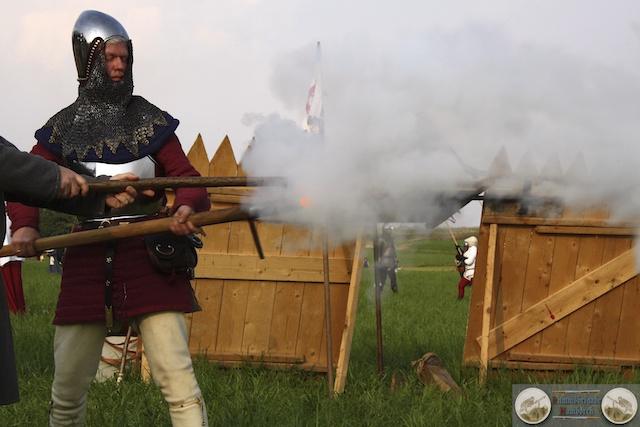
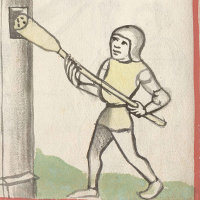
 This type of aiming is occasionally used by shooters in historical illustrations, who often fight at higher targets. The stock is held in the right hand at about hip height, at a distance from the body. The left hand guides the rifle far forward on the stock. Aiming at the target is done intuitively. The firing of the rifle is done by a second man.
This type of aiming is occasionally used by shooters in historical illustrations, who often fight at higher targets. The stock is held in the right hand at about hip height, at a distance from the body. The left hand guides the rifle far forward on the stock. Aiming at the target is done intuitively. The firing of the rifle is done by a second man.
- Advantages: Secure and steady hold of the rifle.
- Disadvantages: Aiming is not possible directly, but only intuitively.
- Application: Direct or ballistic shots at close-standing enemy army clusters, ballistic shots at higher-lying targets.
- Remarks: This type of attack is rarely found in historical sources, and there often in connection with the attack of higher targets such as castles or defence walls. At reenactment and living history events, however, this type of attack is used very frequently. This type of attack offers neither practical nor tactical advantages.
Abbildung: Left: Albertus Picor: Ermordung König Olafs. Fresko Kirche von Kumpla Sala Västmanland, Sweden, um 1482. Right: Mehrläufige Büchse in: [Johannes] Hartlieb: Kriegsbuch; Konrad Kyeser: Bellifortis. Um 1411. Österreichische Nationalbibliothek Wien, Cod. 3069, S. 98.
In the Arm Joint
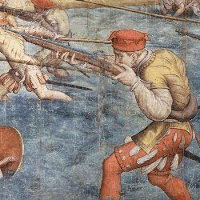
 With the advent of arquebuse type rifles, this new type of aiming appears in the pictorial sources of the late 15th century. The wide end of the stock of the hooked rifle is supported against the crook of the right arm. The right hand holds the rifle at the side and releases the shot via the matchlock via trigger. The left hand guides the rifle in front. Sighting is done with the right eye over the barrel and, if necessary, over the rear sight.
With the advent of arquebuse type rifles, this new type of aiming appears in the pictorial sources of the late 15th century. The wide end of the stock of the hooked rifle is supported against the crook of the right arm. The right hand holds the rifle at the side and releases the shot via the matchlock via trigger. The left hand guides the rifle in front. Sighting is done with the right eye over the barrel and, if necessary, over the rear sight.
- Advantages: Safe and steady hold of the rifle, firing by shooter himself.
- Disadvantages: Stop a little more unsteady than the real shoulder stop.
- Application: Direct precision shots or ballistic shots at more distant targets.
- Remarks: This type of attack can be seen as a preliminary stage or variation to the real shoulder attack, which according to historical illustrations was only used for a few decades in the 16th century. Why this type of stop was used is still a mystery to us.
Images: Left: Die Schlacht im Walde [bei St. Peter b. Nürnberg am 19.06.1502]. Germanisches Nationalmuseum Nürnberg Gm 579. Right: Jan Cornelisz Vermeyen: Tunis-Feldzug Kaiser Karls V. 1546-50, KHM Wien Inv. 2044.
Before the Torso

This type of attachment is only found on a few 16th century sources. Here, the butt end of the hook rifle is either supported against the hull or held a short distance in front of it. This attachment is similar to that of German shooting, but without the rifle strap.3) The right hand holds the rifle at the side and triggers the shot via the matchlock. The left hand guides the rifle in front. Sighting is done intuitively.
- Advantages: Safe and steady hold of the rifle, firing by shooter himself.
- Disadvantages: Aiming only possible intuitively.
- Application: Direct shots at closer targets while advancing on the opponent.
- Remarks: This type of stop is only rarely shown in 16th century illustrations. It is conceivable that it was used when a short sequence of shots was desired but precise aiming was not necessary.
Images: Left: Melchior Feselen: Die Schlacht von Alesia. Süddeutsch um 1533, Bayerisches Nationalmuseum. Right: Ruprecht Heller: Die Schlacht bei Pavia. Nationalmuseum Stockholm, um 1525.
Shoulder Stop
![]()
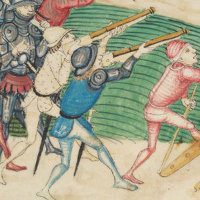 At the same time, or shortly after the arm joint stop, the free-standing shoulder stop appears, which is still used by shooters today. Here the wide end of the stock of the hooked rifle is pulled tight against the shoulder between the collarbone and the muscle bulge. The right hand holds the rifle at the side and releases the shot via the trigger of the matchlock. The left hand guides the rifle in front. Sighting is done with the right eye over the barrel and, if necessary, over the rear sight.
At the same time, or shortly after the arm joint stop, the free-standing shoulder stop appears, which is still used by shooters today. Here the wide end of the stock of the hooked rifle is pulled tight against the shoulder between the collarbone and the muscle bulge. The right hand holds the rifle at the side and releases the shot via the trigger of the matchlock. The left hand guides the rifle in front. Sighting is done with the right eye over the barrel and, if necessary, over the rear sight.
- Advantages: Safe and steady hold of the rifle, firing by shooter himself.
- Disadvantages: No noteworthy.
- Application: Direct precision shots or ballistic shots, also at more distant targets.
- Remarks: Over the last 5 centuries, this has proven to be the best shooting position for the free-standing shooter. In the following centuries, the stocks of rifles and shotguns were ergonomically adapted to this stance.
Images: Left: Diebold Schilling: Amtliche Berner Chronik, Bd. 1. Burgunderbibliothek Bern, Mss hhI 1, Fol 143. Right: Chronicon Helvetiae, Teil II. Wettingen, 1572. Aargauer Kantonsbibliothek, MsWettF 16: 2, fol 113r.
Attached Aiming Types
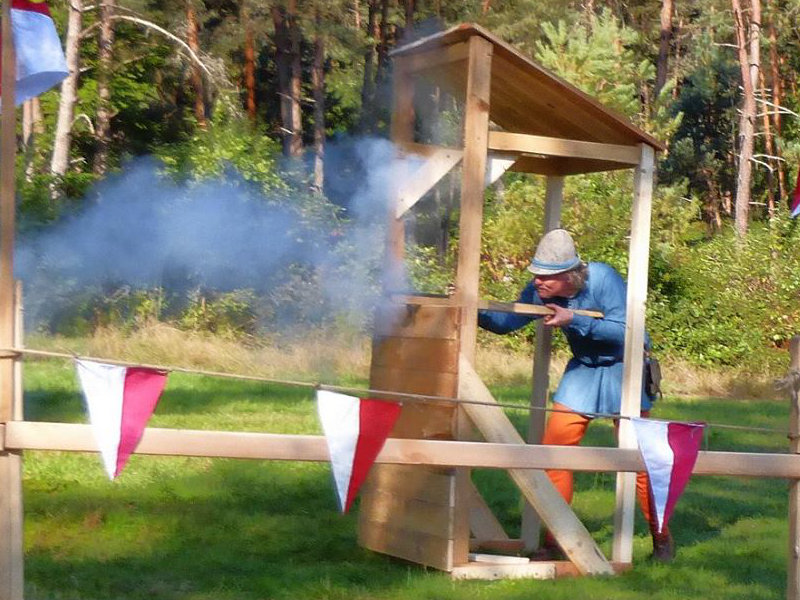
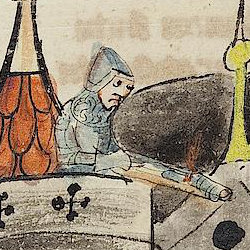
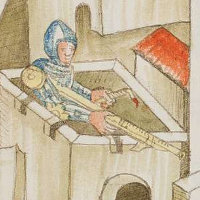
In addition to the above-mentioned free-standing bump stocks, there are countless possibilities for variation with mounted bump stocks, since the shooter has one hand free in addition to the one for aiming the rifle. The use of hooked rifles, which were hung on baffles, embrasures or parapets to absorb the recoil, made it possible to use large-calibre rifles with higher recoil, which could no longer be used freehand.
Images: Left: Kriegsmaschienenbuch. Bayern 15./16. Jh. Herzogin Anna Amlia Bibliothek Wolfenbüttel Cod. Guelf. 161 Blank. S. 95. Right: Konrad Kyeser: Bellifortis. um 1400-1436. Bibliotheca Apostolica Vaticana Cod. Pal. lat. 1994, Fol. 57v.
Einzelnachweise
- For example a left handed arquebuse with serpentine lock of Kunsthistorisches Museums Wienna, Inv. Hofjagd- und Rüstkammer, A 65
- Sammelhandschrift: Taktik der Fehde; Feuerwerkbuch (von 1420); Pulverrezepte; Kriegstechnischer Bilderkatlog. Österreichische Nationalbibliothek Wien Cod. 2952, Capter 38, p. 30
- van der Straet et al (1580): Ill. 22 and 77
- Der Reibert - Das Handbuch für den Soldaten. Mittler, Herford 1982, pp. 88-95
- Artikel Anschlag (Waffe) at German Wikipedia
Text: Andreas Franzkowiak

